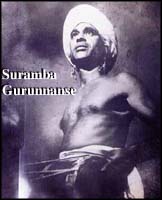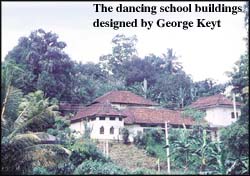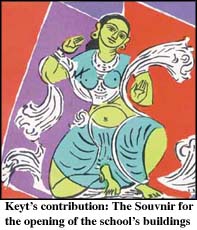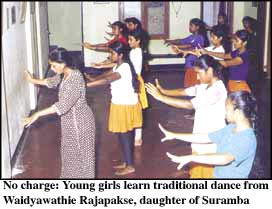
13th February 2000
Front Page|
News/Comment|
Editorial/Opinion| Business|
Sports|
Sports Plus| Mirror Magazine

![]()
Dancing in step with tradition
Launched over 50 years ago amidst much opposition, the Madhyama Lanka Nritya now struggles to survive
By Tharuka Dissanaike
 When
Suramba Gurunnanse first began the Madhyama Lanka Nritya Mandalaya over
50 years ago, there was much opposition, especially from villagers, who
had even stoned the institute's buildings in protest at him 'teaching women
to dance'.
When
Suramba Gurunnanse first began the Madhyama Lanka Nritya Mandalaya over
50 years ago, there was much opposition, especially from villagers, who
had even stoned the institute's buildings in protest at him 'teaching women
to dance'.
But soon the institute's reputation soared and its traditional Kandyan-type buildings are today a landmark in the rural Amunugama in Gunnepana, 20 minutes out of Kandy. Known as the Madhyama Lanka Nritya Mandala, the institute not only taught traditional Kandyan dancing in a school-room environment for the first time, but it also took the dance to the international stage in a big way.
Today three of Suramba Gurunnanse's children run the institute, struggling against modern forces to keep their father's legacy alive.
To celebrate 50 years of the institute and commemorate their father's invaluable contribution to the upliftment of Kandyan art, they have organised a grand show of Kandyan dancing and drumming forms at Mahamaya College during the first week of March. Around 50 of the institute's students will participate in the performance, including several German dancers taught by Suramba or his children.
Suramba Gurunnanse and his younger brother, Sri Jayana came from a family, which traditionally dedicated itself to the Kandyan arts- dancing and drumming. In 1944, the two young men decided to set up a training school to revive the then dying art of Kandyan dancing and train more young people.
Earlier all forms of dancing and drumming were taught in households- knowledge was passed down the generations. But Suramba and Jayana soon realised that this 'Gurukula' system would not help the art survive the waves of modernisation.
The first inaugural meeting of the school was held at Vidyartha College Kandy on December 30, 1944. Here in the presence of two other world reputed dancers, Nittawela Ukkuwa Yadessa and N. Gunaya Yadessa, the Madhyama Lanka Nritya Mandalaya was inaugurated.
But it took four more years before the school was to have permanent buildings and a trained staff serving the students. The main reason for the delay being the departure of Sri Jayana, now the secretary of the institute, to India to further his aesthetic education.
 The
first building of the MLNM was a cadjan hut erected on land purchased by
Suramba Gurunnanse in Gunnepana. Four months afterwards, at a splendid
ceremony presided over by Harold Pieris, a great benefactor of the school,
the foundation stone was laid for the construction of new buildings by
the then Bishop of Kurunegala, Rt. Rev. Lakdasa de Mel. The building designs
were by George Keyt, a great friend of Suramba Gurunnanse.
The
first building of the MLNM was a cadjan hut erected on land purchased by
Suramba Gurunnanse in Gunnepana. Four months afterwards, at a splendid
ceremony presided over by Harold Pieris, a great benefactor of the school,
the foundation stone was laid for the construction of new buildings by
the then Bishop of Kurunegala, Rt. Rev. Lakdasa de Mel. The building designs
were by George Keyt, a great friend of Suramba Gurunnanse.
 When
the school building was inaugurated George Keyt, then a budding artist
working out of Suramba's ancestral home, designed the souvenir cover. Lord
Soulbury, Governor General of the country at the time presided at the opening
and was full of praise for the dancers who took the stage. Many of the
visitors were foreign dignitaries, from Britain and India. This paved the
way for the school's international reputation. Requests for Kandyan dancing
performances came flooding into the Mandalaya and soon foreign students
were admitted to the fold to learn the intricacies of traditional dance.
When
the school building was inaugurated George Keyt, then a budding artist
working out of Suramba's ancestral home, designed the souvenir cover. Lord
Soulbury, Governor General of the country at the time presided at the opening
and was full of praise for the dancers who took the stage. Many of the
visitors were foreign dignitaries, from Britain and India. This paved the
way for the school's international reputation. Requests for Kandyan dancing
performances came flooding into the Mandalaya and soon foreign students
were admitted to the fold to learn the intricacies of traditional dance.
Suramba Gurunnanse was even invited to drum at the coronation of Queen Elizabeth the Second. Later he travelled extensively in England and Europe, especially Germany, with his students performing for the international stage. Among the first batch of students at the institute were a group of women- this being the first time that traditional Kandyan dancing was being taught to women, amidst howls of protests from villagers who believed it was not right for women to perform on stage.
The brothers Suramba and Jayana's attempt to revive Kandyan dancing and drumming did not receive state financial support. Instead, most of the family's private funds were ploughed into the school and its maintenance.
At the beginning several philanthropists helped out with cash donations. Chief among them were Harold Peiris, Sylvester Soyza, Bishop Lakdasa de Mel and Lionel Wendt.
The institute was the first to put on traditional performances for tourists who came to Sri Lanka.
But today to maintain the school and keep it going has become a real challenge.
 "We
do not charge any money from the students. It was against our father's
wishes to charge for lessons," Waidyawathie Rajapakse, Suramba Gurunnanse's
daughter said. She with her elder brother, Suwamegha Rajapakse and younger
sister Iranganie, run the institute today. Several of Suramba's grandchildren
are now on the staff at the institute.
"We
do not charge any money from the students. It was against our father's
wishes to charge for lessons," Waidyawathie Rajapakse, Suramba Gurunnanse's
daughter said. She with her elder brother, Suwamegha Rajapakse and younger
sister Iranganie, run the institute today. Several of Suramba's grandchildren
are now on the staff at the institute.
Since the school makes no money, its upkeep has become a serious issue for the family. Again it's the family's private funds that have so far kept the Mandalaya running and churning out talented dancers. "My entire salary is spent on the school," said Waidyawathie who lectures at the University of Kelaniya. "Instruments and even costumes are very expensive now.
We do not ask the students to provide costumes either- many of them cannot afford it."
Of late the state accords the institute an annual grant of Rs. 3000, but this Waidyawathie said is not even enough to start work on urgent repairs to the buildings. The institute's stage is broken, its roof needs repair and lodging rooms and bathrooms have gone into disuse due of their poor condition.
"We have no television or video, to record dances and drumming for posterity," Waidyawathie said.
She said the most urgent repairs to the school building would cost about Rs. Two lakhs." We want to appeal to the government, the Pradeshiya Sabha and the Diyawadana Nilame in Kandy."
Prior appeals for help to the government, Department of Archaeology and Ministry of Culture had not elicited a response. Waidyawathie lamented that much of the traditional dancing and drumming that is exhibited in the Kandy Perahera was slowly dying out with the passing away of the older generation.
"Many of the older dancers and drummers are loath to publicise their knowledge of the art and it dies with them.
Younger dancers find jobs in the city or go abroad for employment. There is a definite decline in the Kandyan arts. But there has to be a method to preserve and protect these traditions.
"We are willing to do this at the Mandalaya, even train dancers and drummers for the Perahera, but we need more support and encouragement from the state," she said.








![]()
Front Page| News/Comment| Editorial/Opinion| Plus| Business| Sports| Sports Plus| Mirror Magazine
Please send your comments and suggestions on this web site to

